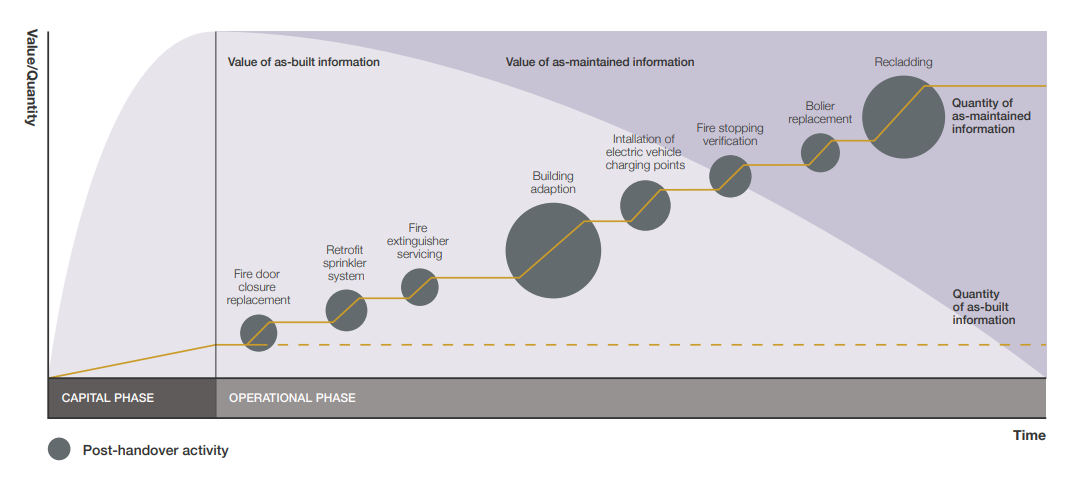Do you really know what’s in your basement? The Golden Thread approach to as maintained information
by Dr Melanie Robinson | March 17, 2023 | 4 min read

Home / Insights / Building Safety / Do you really know what’s …
Why do we maintain buildings but not the information that supports it?
This is the question that underpins much of the Building Safety Act 2022. Over time, our buildings are changed, adapted, reused and refurbished, but the body of information that supports it fails to keep up with these developments. What were originally accurate, as built floor plans and O&M manuals at the point of handover, can quickly become outdated.
For this reason, as the building is used and changes occur, the value of as built information naturally declines. It becomes less and less reliable.

On the other hand, if information is maintained in line with the maintenance and key post handover events of the physical building, it becomes inherently more valuable than the as built information. This is because it is more reliable and accurately reflects the reality of the building.

However, simply creating new as maintained information is not enough. Effective management of this information is crucial in building a structured argument for your Building Safety Case.
What can begin as structured digital information at handover delivered through a BIM enabled process can quickly become superseded by unstructured information as soon as material changes are made. PDFs are saved onto servers or electronic document management systems (EDMS), maybe even in the same folder, but are not named or classified properly with no link to any other piece of information, leading to a jumbled mess of information over time. There may even be some hard copies in there for extra measure!
Say, for example, that your boiler needs replacing. At handover, the O&M documentation, such as the commissioning certificate, is digitally connected to a hyperlinked front end that relies on consistent naming conventions, specific locations within an electronic document management system, and classification codes for optimized documentation searching and linking to the BIM object in the model. (PM_ 70_30_06 and Pr _60_60_08, in case anyone is wondering). At the point of handover, this as built information ecosystem is interconnected and reflective of reality. Great!
But then, the boiler breaks down beyond repair and we need to replace the boiler with a brand new shiny one.
With the brand new shiny boiler comes brand new shiny information. The boiler may be a different model with its own instructions, warranty information and commissioning certificate. It will have information pertaining to running costs and performance specifications. It will also have information relating to the work order that initiated the boiler replacement and any changes that have taken place since.
Basically, the quantity of information you hold on your boiler has grown and you now have plenty of as maintained information… so, what now?
How do you make sure that it doesn’t become a jumbled mess and, more importantly, that you can comply with the legislative requirements of the Building Safety Act and satisfy the Regulator?
The simple answer is structured information management. Try asking yourselves these questions:
- Do you have a controlled workflow for your as maintained information to be incorporated into your information ecosystem?
- Is this information searchable and simple to access through a consistent naming and classification protocol?
- Can you share this information with the people who need access to it? Is it secure and in a format that can be accepted by various systems?
- Does this information identify who is responsible for this information and provide you with a clear audit history of the decisions surrounding it?
- Do you have procurement procedures in place for structured digital information?
These principles are the foundations of the Golden Thread and are essential for maintaining the safety and compliance of a building throughout its lifecycle.
By following these principles, building owners and operators can ensure that their as maintained information remains accessible, searchable and relevant, avoiding the pitfalls of an incoherent information mess and instead building a reliable and comprehensive information ecosystem that supports compliance with the Building Safety Act.
If you would like to know more, read my recent article on as maintained information as digital shadows, download this free ebook on How to Develop a Building Safety Case: 4 Stages to Compliance which I have recently published, or contact me directly at [email protected].
About the author
Dr Melanie Robinson
Associate, BIM Academy
Melanie is an Associate at BIM Academy, specialising in building information modelling (BIM) and information management according to ISO 19650.
Melanie manages several projects across multiple sectors globally, and works closely with international clients to develop digital strategies for project and asset management.
Melanie’s specialisms include change management, standardisation and digital collaboration, and she acts as a Regional Lead for Women in BIM (WIB).
Melanie holds a PhD from Edinburgh Napier University (ENU) which looked into the micro-level factors to an effective macro-level diffusion of BIM, including the gap between perceived and actual efficacy of BIM understanding and skills. She is also an award-winning graduate of ENU’s Architectural Technology programme, having obtained a first-class Honours degree in 2015.


